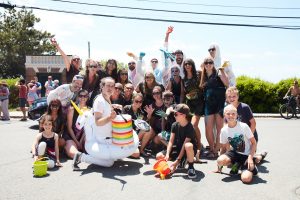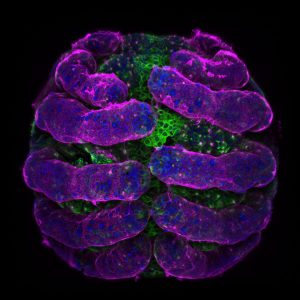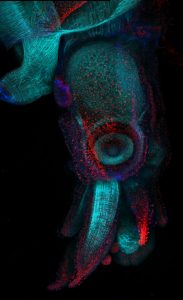The MBL Embryology Course: Questions and Answers
Posted by Tessa Montague, on 17 January 2018
The Feburary 1st deadline to apply to the Embryology Course at the Marine Biological Laboratory (MBL) is quickly approaching. Maybe you’ve only just learned about the Embryology Course, or perhaps you’ve been meaning to apply to it for years but never pulled the trigger. Either way, I’m writing this blog post to (1) convince you to apply to the course and (2) answer any questions (I imagine) you might have about the experience.
First, some background. The Embryology Course was founded in 1893 at the MBL in the picturesque New England town of Woods Hole. The MBL is a world-renowned institution, and its visiting and resident scientists have made many major scientific contributions over the years, including the discovery of microtubules, kinesin, the squid giant axon, cyclin and GFP. The Embryology Course is one of the outstanding summer courses offered at the MBL. Since its inception, 6 Embryology students and 8 Embryology faculty members have won Nobel Prizes, and many others have become leaders in the field.
I took the Embryology Course in 2017 with 23 other scientists from around the world. It was an amazing and, literally, life-changing experience for me (see later). However, I was hesitant about applying because I wasn’t sure I had the time to take the course, and I didn’t know very much about it. Below I have asked questions that Tessa-circa-January-2017 would have wanted the answers to, and I’ve answered them with my newfound wisdom. I hope you find it useful.
Who can apply for the course? What stage of your career should you be in?
The course is designed for scientists at a range of career stages. The course directors strike a great balance of admitting junior to senior graduate students, postdocs, and a token faculty member (we love you Steve!) In general Embryology students are already in graduate school (or beyond), although we had the pleasure of being joined for a week by undergraduate Evan Brooks, who was selected to participate as a Society for Developmental Biology (SDB) Choose Development! Fellow.
Embryology students come from all over the world, which is one of the forms of diversity we really cherish. Last year we had students from Brazil, Poland, Chile, Australia, the USA, Spain, India, the Czech Republic, France, the U.K., Canada, Germany and Sri Lanka. Not bad!

Is it okay to have never studied developmental biology in your life? Is it okay to already know quite a lot about developmental biology?
Yes and yes. Students came into our course with very different specialties, which was a great strength. There were experts in computational biology, engineering, evolutionary biology, physics, cell biology, genetics, developmental biology and mathematics. The scientific diversity made our discussions all the more interesting, strengthened the partnerships we formed to tackle biological questions, and was a fantastic way to learn from one another.
Why do people usually take the course?
There are many reasons. For my classmates the motivations included: (i) to learn how to do experimental biology; (ii) to find an exciting lab to do a postdoc in; (iii) to learn more about the field of developmental biology before transitioning into it; (iv) to find the model organism and question to motivate their research for the next 5+ years; (v) to finally meet Ray Keller in person.
How is the course structured?
The course comprises 6 modules (1 per week) that are organized by organism. We had modules that covered the more traditional model systems, such as ‘Zebrafish and Frogs’ and ‘Chicks and Mice’ and others that introduced weird and wonderful beasts, such as ‘Urochordates, Hemichordates, Cephalochordates, and Ctenophores’ and ‘Nematostella, Hydra, Acoels, Planaria, Molluscs, & Annelids’. In total, we estimate we were exposed to almost 100 different animal species! With each module came an outstanding array of faculty who introduced us to their organism, explained their lab’s research, and showed us the tricks of the trade.
What happens on a typical day on the Embryology Course?
I wrote an article for SDB that outlines a typical day on the course. Enjoy!

I’m kind of busy this year. Maybe I’ll apply next year.
That’s not a question…
Most of us find excuses for not applying to the course… “Now’s not a good time – maybe next year”… “Think of all the ground-breaking research I could do in my home lab in 6 weeks”… “I like sleeping”…
It will never be the perfect time to take the course, so just make it work. You will; we did. Anna Czarkwiani wrote a great article about why you should be fearless and apply for the course.
The course is expensive. How do I pay for it?
You should try to find some funding from your home institution, fellowship or advisor, but the course can also provide generous support to help cover the costs (we are very grateful to a number of private and public sponsors including the Company of Biologists and SDB). Money shouldn’t prevent you from applying to the course, and you don’t need to have all the funding when you send in your application.
What is the living and eating situation?
Housing is provided on campus in a room you share with another student at the course. It may sound a little daunting to share a room, but it is easy and fun and another great way to make a close friend. Our meal plan provided 3 meals per day at MBL’s cafeteria, Swope. It may not be the luxurious dining experience of your dreams, but Swope has multiple healthy (and some non-healthy) options, a full salad bar every day, an array of desserts, and lots of coffee. Most importantly, it is quite pleasant to have food prepared for you every day. What a luxury! I welcomed the 6-week period I didn’t have to rummage for food every time I got hungry.
When students experienced palate fatigue, we ate at the restaurants in Woods Hole. In addition, each faculty member was taken to dinner by two students, so on those nights we enjoyed some very fine (and free) dining. There is also a great bakery in town, Pie in the Sky, which is open late, so there was always somewhere to get snacks to keep us going.
Will I get no sleep for 6 weeks? I’m a mess when I don’t sleep.
Wow, me too! As you will read in the other articles about the Embryology Course, sleep is often forsaken in favor of science, socializing or both. That’s one of the magical elements of the course and the MBL: there is so much enthusiasm and energy in the air that people don’t even notice they’re staying up later and later and sleeping less and less. With that said, some people can tolerate extreme sleep deprivation while others can’t. I am one of the people who can’t, so if I got a short night, I would usually follow it with a longer one – we make our own evening schedules so there’s no pressure to stay up really late. Some students took power naps during the day, and others maintained a ‘healthy’ blood caffeine concentration. I settled into the habit of taking an afternoon stroll to Pie in the Sky and getting an afternoon coffee and PBJ bagel to pick me up.
What do you do in your time off? Do you have any time off?
Lectures and labs run from Monday-Saturday, so Sunday is our day off. We usually did some combination of: sleeping, going for bike rides on the beautiful ocean bike path, cycling/driving to Falmouth to visit the French bakery, sleeping, lying on the beach, playing softball and basketball, having parties and barbecues at course directors Dave Sherwood’s or Rich Schneider’s house, swimming in the sea, sleeping, etc. One Sunday we went on a great whale watching trip from Provincetown.

What lasting effect has the course had on you?
For me, it has had two major effects: (1) it has given me confidence, and (2) it has changed my life (remember?)
In addition to learning new experimental skills and honing my problem-solving and microscopy prowess, the course gave me the confidence to ask lots of questions during the so-called Sweat Box that follows lecture. I stopped worrying about whether I was asking “good” questions and it was quite liberating. In addition, although the majority of my experiments failed, I also experienced moments of awe and wonder (for instance, watching a tardigrade dump an almighty poop before my eyes) and I had some successes. Since completing the course, a time lapse I made of 9 organisms developing for 24 hours with my classmate Zuzka Vavrušová recently became a winner of the FASEB BioArt Competition. In addition, some of my work has been shared online by Zeiss and SDB, and a recent article on the Harvard Medical School news site used a video I made of the crazy contractions of a fertilized Xenopus egg to illustrate new research by Marc Kirschner’s group. It turns out that everyone thinks embryos are amazing (..duh).
And the course changed my life. I went into it hoping to find an organism and a question to challenge and inspire me for my postdoc and beyond, and I found it. Since the course ended I have interviewed for postdocs on a crazy cephalopod project I would never have conceived before the course, and I have been awarded a Grass Fellowship to begin my cephalopod project at the MBL next summer for 3 months. I am really excited about my scientific future, and I am so inspired by and grateful for the experience I had on the Embryology Course.
Final thoughts?
The Embryology Course is a wonderful, messy, exciting and extremely fun experience that will leave you with friends-for-life, a network of faculty members around the world who might be your colleagues one day, skills in microscopy, embryology, troubleshooting, softball, and a constant source of inspiration and confidence. But to really know what the Embryology Course is like, you’ll have to take it yourself.


 (8 votes)
(8 votes)